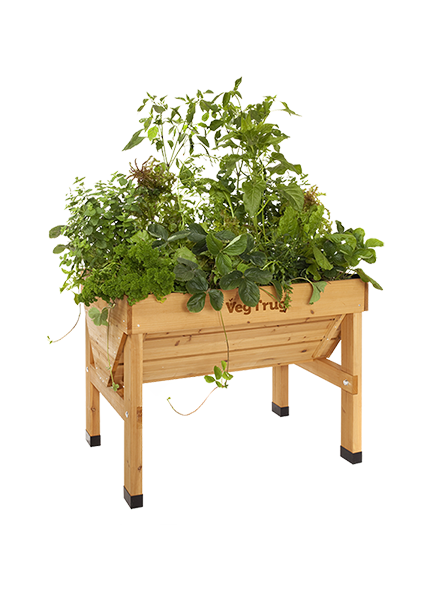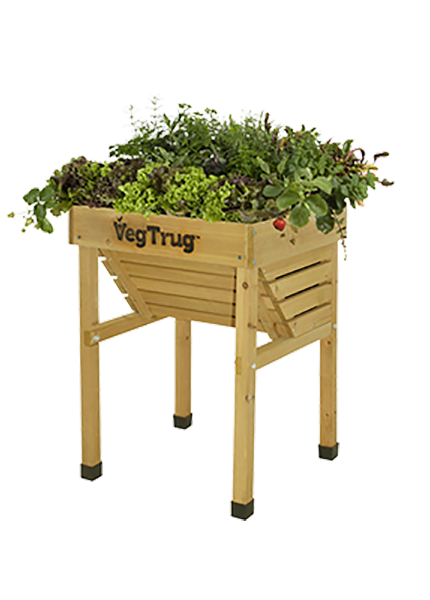The humble potato helped create farming as we know it today. Its arrival from Peru to northern Europe in the late 1500s staved off famine, introduced an agricultural revolution and the use of fertiliser and insecticides in farming.
And if you want to know how to grow potatoes, you’re in company that dates back possibly as far as 10,000 years.
There’s a huge choice when it comes to choosing which potatoes you want to grow and they’ll thrive happily in bags or a quality container, like a VegTrug.
Read more on how to grow potatoes below.
Before planting you should ‘chit’ them. Leave your seed potatoes for about 4 weeks in a cool but light place, not a dark cupboard, so shoots can start to grow. With their individual compartments, egg boxes offer a good home, as you don’t want to pile the potatoes on top of each other.
Potatoes are generally earlies or maincrops. Maincrops stay in the ground longer and produce larger potatoes. Earlies are harvested earlier and are much smaller. ‘New potatoes’ are, for example, earlies.
To start, you’ll be planting seed potatoes and the shoots from the seed potatoes will create the tubers, vegetables that grow in the soil on the root of a plant.
While any potato is capable of producing roots, supermarket potatoes might be treated, to prolong their shelf life, and not produce quality shoots. Choose a disease-free seed from a quality supplier instead.
Plant your seed potatoes in spring, but no earlier than a month before the last frost is expected. Potatoes like the soil to be warm, at least 7°C, before they will start to germinate and can rot if the soil is too wet. Plant in well-drained soil.
Potatoes need a sunny home. Also be aware that any late frosts can damage new leaf growth.
The trench should be around 15cm deep and each potato spaced out around 30cm apart.
Once you learn the techniques of how to grow potatoes successfully, you can enjoy a good yield of this tasty crop and try varieties that aren’t frequently available in the shops.
Water your potatoes well and add soil around the base as the plants get bigger, keeping just a few inches of shoots sticking out the top. Once the first shoots are around 22cm tall, you should add soil to a height of about 15cm. As they grow, add more soil.
This protects the young shoots and stops the emerging potatoes turning green and therefore becoming inedible.
Put the word potato in front of blight, rot, scab, blackleg and you have a range of diseases you might find when you’re learning how to grow potatoes.
There are two blights, early and late. Late potato blight often appears when there is a wet but warm summer. And it’s difficult to remedy. The leaves turn to a wet rot, the stems can have lesions too, or the tubers have a reddish-coloured decay. But removing leaves just stops the tuber’s ability to grow more. Earthing up offers some protection and planting for early harvesting helps, because the chance of blight increases with the progression of summer.
In contrast, early blight is fungal disease from a different organism, and more often reported in North America.
You can help control blackleg by removing the affected leaves and rotating where you grow the crop.
Potato scab won’t be seen until you lift the potatoes. It can’t be controlled but won’t affect the taste. It’s easily removed through peeling, and keeping your potatoes properly watered in dry seasons can help. Similarly, with potato rot you might not see it until you pull them up.
The different varieties are harvested at different times. Earlies typically need 100 days, whereas maincrops will need around 120.
Earlies don’t store that well, so dig them up as you need them. When the potatoes are about the size of an egg, cut the stems and leaves to ground level and gently prize up the potatoes with a fork.
With maincrops wait until the leaves have turned yellow and died back, then cut the plants to ground level and gently lift with a fork.
Store your potatoes in a cool, dry place and they’ll be good for a few months. Frost will damage them. Remove any that have signs of rot or scab and keep an eye on any signs of disease on the stored ones. Finally, don’t wash them before you store them.
How to grow potatoes is part of the VegTrug grower’s guide.

